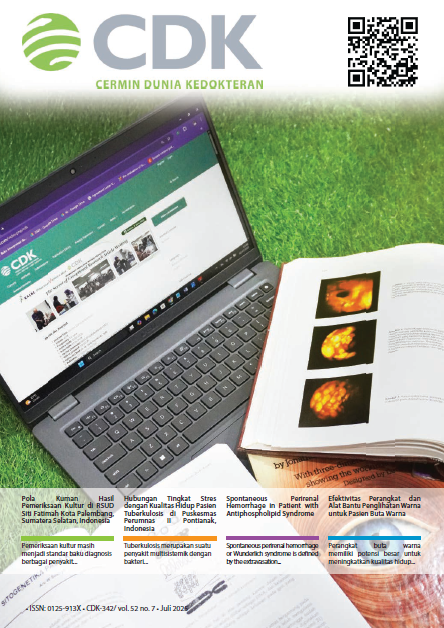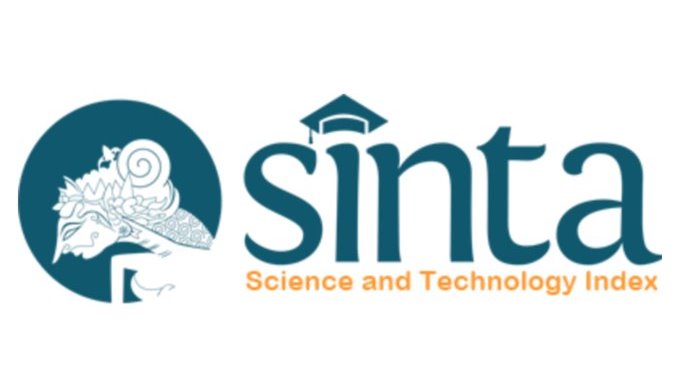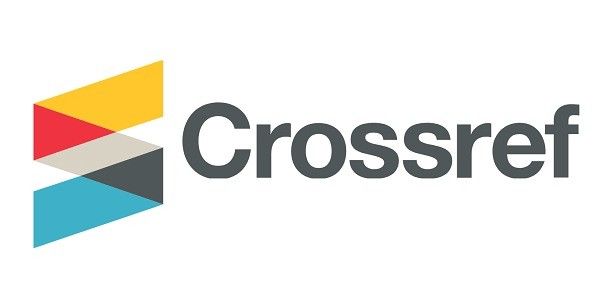Efikasi Statin pada Tata Laksana Oftalmopati Graves
Analisis
DOI:
https://doi.org/10.55175/cdk.v52i7.1546Kata Kunci:
Kolesterol, oftalmopati Graves, penatalaksanaan, penyakit autoimun tiroid, statinAbstrak
Oftalmopati Graves (OG) merupakan manifestasi klinis penyakit autoimun tiroid pada mata. Terjadinya inflamasi dan remodelling jaringan penyakit OG dapat menyebabkan keluhan ringan hingga berat yang bisa merusak saraf pada mata dan berujung pada kebutaan. Identifikasi dini diagnosis, klasifikasi aktivitas dan derajat keparahan penyakit, serta faktor risiko penyakit diperlukan. Hal ini dapat membantu penatalaksaan lanjutan yang komprehensif guna mencegah kerusakan berat dan permanen. Faktor endogen (tidak dapat dimodifikasi), eksogen (dapat dimodifikasi), dan lingkungan berinteraksi secara kompleks sebagai faktor risiko OG. Hiperkolestrolemia yang juga disebabkan oleh adanya inflamasi sistemik jangka panjang, menjadi salah satu faktor risiko yang diyakini berhubungan dengan OG. Hal ini dapat diatasi salah satunya dengan pemberian obat-obatan golongan statin. Selain berperan untuk menurunkan kadar kolesterol di dalam darah, statin juga memiliki efek preventif dan terapeutik pada pasien OG terutama pada pasien dengan klasifikasi OG aktif derajat sedang-berat. Statin juga memiliki efek pleiotropik, berperan sebagai imunoregulator, bekerja dengan menghambat adipogenesis serta bersinergi dengan terapi methylprednisolone pada penatalaksanaan OG.
Unduhan
Referensi
Men CJ, Kossler AL, Wester ST. Updates on the understanding and management of thyroid eye disease. Ther Adv Opthalmol. 2021;13:25158414211027760. DOI: 10.1177/25158414211027760.
Moledina M, Damato EM, Lee V. The changing landscape of thyroid eye disease: Current clinical advances and future outlook. Eye (Lond). 2024;38(8):1425–37. DOI: 10.1038/s41433-024-02967-9.
Bartalena L, Kahaly GJ, Baldeschi L, Dayan CM, Eckstein A, Marcocci C, et al. The 2021 European group on Graves’ orbitopathy (EUGOGO) clinical practice guidelines for the medical management of Graves’ orbitopathy. Eur J Endocrinol. 2021;185(4):G43–67. DOI: 10.1530/EJE-21-0479.
Chin YH, Ng CH, Lee MH, Koh JWH, Kiew J, Yang SP, et al. Prevalence of thyroid eye disease in Graves’ disease: A meta-analysis and systematic review. Clin Endocrinol. 2020;93(4):363–74. DOI: 10.1111/cen.14296.
Lanzolla G, Comi S, Cosentino G, Pakdel F, Marino M. Statins in Graves orbitopathy: A new therapeutic tool. Ophthalmic Plast Reconstr Surg. 2023;39(6S):S29–39. DOI: 10.1097/IOP.0000000000002525.
Nilsson A, Tsoumani K, Planck T. Statins decrease the risk of orbitopathy in newly diagnosed patients with Graves disease. J Clin Endocrinol Metab. 2021;106(5):1325–32. DOI: 10.1210/clinem/dgab070.
Malboosbaf R, Maghsoomi Z, Emami Z, Khamseh ME, Azizi F. Statins and thyroid eye disease (TED): A systematic review. Endocrine 2024;85(1):11–7. DOI: 10.1007/s12020-023-03680-5.
Marino M, Lanzolla G, Marcocci C. Statins: A new hope on the horizon of Graves orbitopathy? J Clin Endocrinol Metab. 2021;106(7):e2819–21. DOI: 10.1210/clinem/dgab184.
Muralidhar A, Das S, Tiple S. Clinical profile of thyroid eye disease and factors predictive of disease severity. Indian J Ophthalmol. 2020;68(8):1629-34. DOI: 10.4103/ijo.IJO_104_20.
Gandhi R, Durairaj VD, Shah K, Nguyen Burkat C, Epley KD, Phelps PO, et al. Thyroid eye disease. American Academy of Ophthalmology (AAO) [Internet]. 2024. Available from: https://eyewiki.org/Thyroid_Eye_Disease.
Bartalena L, Gallo D, Tanda ML, Kahaly GJ. Thyroid eye disease: Epidemiology, natural history, and risk factors. Ophthalmic Plast Reconstr Surg. 2023;39(6S):S2-8. DOI: 10.1097/IOP.0000000000002467.
Korn BS. 2021-2022 Basic and clinical science course, section 7: Oculofacial plastic and orbital surgery. In: Rapuano CJ, Stout J, McCannel C, editors. American Academy of Ophthalmology; 2021.
Weiler DL. Thyroid eye disease: A review. Clin Exp Optom. 2017;100(1):20–5. DOI: 10.1111/cxo.12472.
Lim NCS, Sundar G, Amrith S, Lee KO. Thyroid eye disease: A Southeast Asian experience. Br J Ophthalmol. 2015;99(4):512–8. DOI: 10.1136/bjophthalmol-2014-305649.
Campi I, Fugazzola L. How can we prevent disease relapse in Graves’ orbitopathy after immunosuppressive treatment? Expert Rev Endocrinol Metab. 2022;17(4):269–74. DOI: 10.1080/17446651.2022.2100344.
Lanzolla G, Sabini E, Marenza L, Francesca M, Rocchi R, Sframeli A, et al. Statins for Graves’ orbitopathy (STAGO): A phase 2, open-label, adaptive, single centre, randomised clinical trial. Lancet Diabetes Endocrinol. 2021;9(11):733–42. DOI: 10.1016/S2213-8587(21)00238-2.
Nancy AM. Adding statins to steroids in thyroid eye disease improves outcomes. Medscape [Internet]. 2021. Available from: https://www.medscape.com/viewarticle/960172.
Lanzolla G, Vannucchi G, Ionni I, Campi I, Sileo F, Lazzaroni E, et al. Cholesterol serum levels and use of statins in Graves’ orbitopathy: A new starting point for the therapy. Front Endocrinol (Lausanne). 2019;10:933. DOI: 10.3389/fendo.2019.00933.
Busnelli M, Manzini S, Froio A, Vargiolu A, Cerrito MG, Smolenski RT, et al. Diet induced mild hypercholesterolemia in pigs: Local and systemic inflammation, effects on vascular injury – rescue by high-dose statin treatment. PLos One. 2013;8(11):e80588. DOI: 10.1371/journal.pone.0080588.
Naselli A, Moretti D, Regalbuto C, Arpi ML, Lo Giudice F, Frasca F, et al. Evidence that baseline levels of low-density lipoproteins cholesterol affect the clinical response of Graves’ ophthalmopathy to parenteral corticosteroids. Front Endocrinol. 2020;11:609895.
Rotondo Dottore G, Bucci I, Lanzolla G, Dallan I, Sframeli A, Torregrossa L, et al. Genetic profiling of orbital fibroblasts from patients with Graves’ orbitopathy. J Clin Endocrinol Metab. 2021;106(5):e2176–90. DOI: 10.1210/clinem/dgab035.
Sabini E, Mazzi B, Profilo MA, Mautone T, Casini G, Rocchi R, et al. High serum cholesterol is a novel risk factor for Graves’ orbitopathy: Results of a cross-sectional study. Thyroid 2018;28(3):386–94. DOI: 10.1089/thy.2017.0430.
Lanzolla G, Sabini E, Profilo MA, Mazzi B, Sframeli A, Rocchi R, et al. Relationship between serum cholesterol and Graves’ orbitopathy (GO): A confirmatory study. J Endocrinol Invest. 2018;41(12):1417–23. DOI: 10.1007/s40618-018-0915-z.
Hsu GCY, Shih SR, Chang FY, Liao SL, Wei YH. An appraisal of the preventive effect of statins on the development of Graves’ ophthalmopathy: A hospital-based cohort study. Ophthalmol Ther. 2024;13(6):1499–511. DOI: 10.1007/s40123-024-00930-1.
Fonseca FAH, Izar MCO. Primary prevention of vascular events in patients with high levels of C-reactive protein: The JUPITER study. Expert Rev Cardiovasc Ther. 2009;7(9):1041-56. DOI: 10.1586/erc.09.93.
Bełtowski J, Wojcicka G, Jamroz-Wisniewska A. Adverse effects of statins - mechanisms and consequences. Curr Drug Saf. 2009;4(3):209–28. DOI: 10.2174/157488609789006949.
Bifulco M, Ciaglia E. Statin reduces orbitopathy risk in patients with Graves’ disease by modulating apoptosis and autophagy activities. Endocrine 2016;53(3):649–50. DOI: 10.1007/s12020-015-0762-z.
Kawashima A, Tanigawa K, Akama T, Yoshihara A, Ishii N, Suzuki K. Innate immune activation and thyroid autoimmunity. J Clin Endocrinol Metab. 2011;96(12):3661–71. DOI: 10.1210/jc.2011-1568.
Fulcher J, O’Connell R, Voysey M, Emberson J, Blackwell L, Mihaylova B, et al. Efficacy and safety of LDL-lowering therapy among men and women: Meta-analysis of individual data from 174,000 participants in 27 randomised trials. Lancet. 2015;385(9976):1397–405. DOI: 10.1016/S0140-6736(14)61368-4.
Koch CA, Krabbe S, Hehmke B. Statins, metformin, proprotein-convertase-subtilisin-kexin type-9 (PCSK9) inhibitors and sex hormones: Immunomodulatory properties? Rev Endocr Metab Disord. 2018;19(4):363–95. DOI: 10.1007/s11154-018-9478-8.
Clark JE, Stan MN. Statin use associated with lower incidence of developing thyroid eye disease in newly-diagnosed Graves’ disease. Clin Thyroidology. 2021;33(6):266–8. DOI: 10.1089/ct.2021;33.266-268.
Unduhan
Diterbitkan
Cara Mengutip
Terbitan
Bagian
Lisensi
Hak Cipta (c) 2025 Maria Vania Tri Ekaputri, Megawati Tanu

Artikel ini berlisensi Creative Commons Attribution-NonCommercial 4.0 International License.





















